Poor Alex :(. If You Don’t Get It, You Can’t Be An Engineer 😂.

Poor Alex :(. If you don’t get it, you can’t be an engineer 😂.
More Posts from Engineeringtrivia-blog and Others










Smithsonian’s National Air & Space Museum Udvar-Hazy Center in Chantilly, Virginia, offers the unique sight of a complete Mercury spacecraft. Many of these spacecraft are available for viewing all over the United States, but this one is special because it did not fly.
During the course of a Mercury flight, several parts of the spacecraft are jettisoned and not recovered, including the retro package. This piece of equipment is visible here in my photos as the striped metal object strapped to the bottom of the heat shield. This small cluster of solid rocket motors was responsible for the safe return of the astronaut from space, making just enough thrust to change the shape of the orbit so that it would meet the atmosphere and use aerobraking for a ballistic reentry.
If this package had not fired properly, the astronaut would be faced with the dire situation of being stuck in orbit. Fortunately, this never happened in real life, but it was captured in the fanciful novel “Marooned” by Martin Cardin, in which a NASA astronaut was stranded on orbit after his retro rockets failed. When the book was released in 1964, it was so influential that it actually changed procedures for Mercury’s follow on program Project Gemini, adding more redundancy to the spacecraft’s reentry flight profile.
Alan Shepard, the first American in space and later Apollo 14 moonwalker, didn’t fail to notice that there was a leftover spacecraft at the end of the Mercury program. He lobbied for a second Mercury flight in this ship, speaking personally to both NASA Administrator James Webb and President John Kennedy about this flight. He told them his idea of an “open ended” mission in which they would keep him in orbit indefinitely until there was a malfunction or consumables began to run out. Webb stated (and Kennedy agreed) that it was more important to shelve the Mercury spacecraft in order to jump start the more capable Gemini Program. Thus, we now have this whole Mercury on display for future generations to appreciate.









Gravitational Waves Win 2017 Nobel Prize In Physics, The Ultimate Fusion Of Theory And Experiment
“The 2017 Nobel Prize in Physics may have gone to three individuals who made an outstanding contribution to the scientific enterprise, but it’s a story about so much more than that. It’s about all the men and women over more than 100 years who’ve contributed, theoretically and experimentally and observationally, to our understanding of the precise workings of the Universe. Science is much more than a method; it’s the accumulated knowledge of the entire human enterprise, gathered and synthesized together for the betterment of everyone. While the most prestigious award has now gone to gravitational waves, the science of this phenomenon is only in its earliest stages. The best is yet to come.”
It’s official at long last: the 2017 Nobel Prize in Physics has been awarded to three individuals most responsible for the development and eventual direct detection of gravitational waves. Congratulations to Rainer Weiss, Kip Thorne, and Barry Barish, whose respective contributions to the experimental setup of gravitational wave detectors, theoretical predictions about which astrophysical events produce which signals, and the design-and-building of the modern LIGO interferometers helped make it all possible. The story of directly detecting gravitational waves is so much more, however, than the story of just these three individuals, or even than the story of their collaborators. Instead, it’s the ultimate culmination of a century of theoretical, experimental, and instrumentational work, dating back to Einstein himself. It’s a story that includes physics titans Howard Robertson, Richard Feynman, and Joseph Weber. It includes Russell Hulse and Joseph Taylor, who won a Nobel decades earlier for the indirect detection of gravitational waves. And it’s the story of over 1,000 men and women who contributed to LIGO and VIRGO, bringing us into the era of gravitational wave astronomy.
The 2017 Nobel Prize in Physics may only go to three individuals, but it’s the ultimate fusion of theory and experiment. And yes, the best is yet to come!
Why is Glass Transparent?
We are now in ‘The Glass Age’. It is impossible to imagine a world without glass. From Mobile phones to glass panels, it is omnipresent.
Such a pivotal role does Glass play in our day to day to lives, but yet when confronted with the question - “why is glass transparent?”, we are speechless! But hey! This post is dedicated to answering that burning question.
How do we see things ?
Lights travels in straight lines. When light hits an object, it bounces off other objects (reflects) and enters our eyes. And this information is processed by our brain and this is how we see the object.

An atomic interlude.
You may know that an Atom consists of a nucleus with electrons orbiting around it. These electrons are confined to a trajectory known as an Orbit. And there exists a gap between two subsequent orbits where no electron can exist. Known as an energy-gap or a band gap( Band gap ).
And for an electron to jump from one orbit to another:
It must gain energy and jump to a higher level. ( Away from the nucleus )
It must lose energy and jump to a lower level. ( Closer to the nucleus)
The energy to make such transitions is provided by light.

What decides whether an object is Transparent, Translucent or opaque?
Imagine you are now a photon. And you are in a collision course with a material.There are three possible outcomes:

The substance absorbs the photon. This occurs when the photon gives up its energy to an electron located in the material. Armed with this extra energy, the electron is able to move to a higher energy level, while the photon disappears.
The substance reflects the photon. To do this, the photon gives up its energy to the material, but a photon of identical energy is emitted.
The substance allows the photon to pass through unchanged. Known as transmission, this happens because the photon doesn’t interact with any electron and continues its journey until it interacts with another object.
Glass, of course, falls into this last category. Photons pass through the material because they don’t have sufficient energy to excite a glass electron to a higher energy level. And due to this, we are able to see through glass!

If the material absorbs the photon, it is said to be opaque. And if it allows some photon to pass through and others get absorbed, the material is termed Translucent.
Smart Glass.
Glass does not necessarily have to transparent/ translucent/ opaque all the time.
Smart glass is glass whose light transmission properties are altered when voltage, light or heat is applied. Generally, the glass changes from translucent to transparent, changing from blocking some (or all) wavelengths of light to letting light pass through.



Hydro Robotics! 1/3

Dawn O'Mara sitting on the edge of the front cockpit of a de Havilland DH82 Tiger Moth biplane, circa 1953.
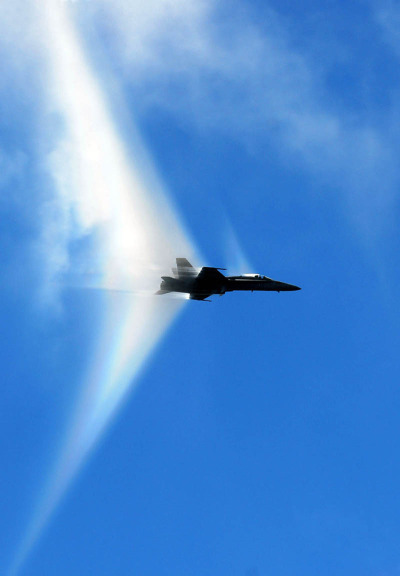

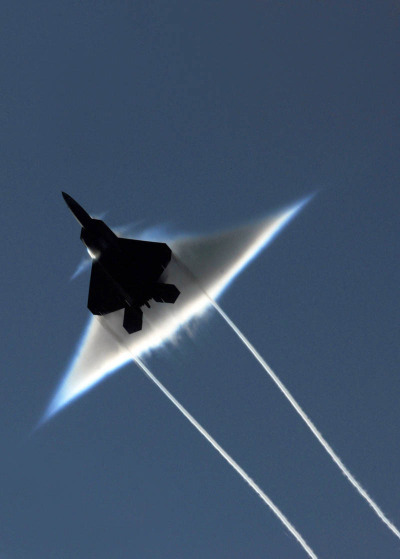
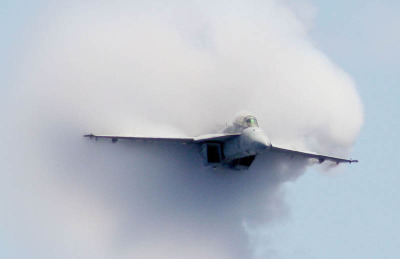
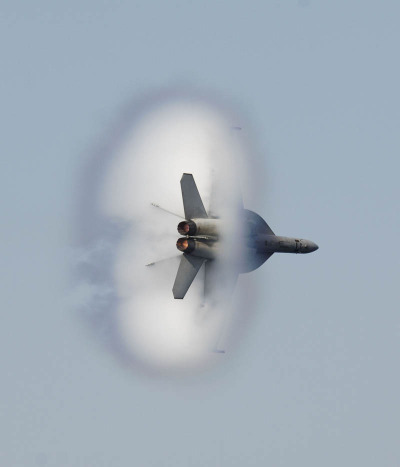

The Vapor Cone.
A vapor cone, also known as shock collar or shock egg, is a visible cloud of condensed water which can sometimes form around an object. A vapor cone is typically observed as an aircraft, or object, flying at Transonic speeds. ( slightly slower than the speed of sound)
The Pressure - Temperature dependence.
As the aircraft approaches the speed of sound, the air pressure around the object drops, and thereby the air temperature drops. If the temperature drops below the dew point, water in the atmosphere condenses to form a cloud in the shape of the shockwave.
Red Bull Stratos and the Vapor Cone.
Remember that epic jump where Felix Baumgartner, as a part of the Red Bull Stratos project broke the sound barrier ( reached Mach 1.25 ) during his descent? But why weren’t vapor cones seen around Felix’s body? Or were they?

Vapor cones are formed only near the ground, where plenty of wet air persists. But when Felix broke the sound barrier, there was no wet air that surrounded him that would enable the formation of Vapor cones.
Have a Good day!
PC: twistedsifter
Take a Virtual Tour of NASA
Welcome to NASA! Today, we’re taking you behind-the-scenes for a virtual tour looking at our cutting-edge work and humanity’s destiny in deep space!

Starting at 1:30 p.m., we will host a series of Facebook Live events from each of our 10 field centers across the country. Take a look at where we’ll be taking you…
Glenn Research Center 1:30 p.m. EDT

Our Glenn Research Center in Cleveland, OH will host a tour of its Electric Propulsion Lab. This lab is where we test solar propulsion technologies that are critical to powering spacecraft for our deep-space missions. The Electric Propulsion Laboratory houses two huge vacuum chambers that simulate the space environment.
Marshall Space Flight Center 1:50 p.m. EDT

Our Marshall Space Flight Center in Huntsville, AL will host a tour from a Marshall test stand where structural loads testing is performed on parts of our Space Launch System rocket. Once built, this will be the world’s most powerful rocket and will launch humans farther into space than ever before.
Stennis Space Center 2:10 p.m. EDT

Our Stennis Space Center in Bay St. Louis, MS will take viewers on a tour of their test stands to learn about rocket engine testing from their Test Control Center.
Armstrong Flight Research Center 2:30 p.m. EDT

Our Armstrong Flight Research Center in Edwards, CA will host a tour from their aircraft hangar and Simulator Lab where viewers can learn about our X-Planes program. What’s an X-Plane? They are a variety of flight demonstration vehicles that are used to test advanced technologies and revolutionary designs.
Johnson Space Center 2:50 p.m. EDT

Our Johnson Space Center in Houston, TX will take viewers on a virtual exploration trip through the mockups of the International Space Station and inside our deep-space exploration vehicle, the Orion spacecraft!
Ames Research Center 3:10 p.m. EDT

Our Ames Research Center in California’s Silicon Valley will bring viewers into its Arc Jet Facility, a plasma wind tunnel used to simulate the extreme heat of spacecraft atmospheric entry.
Kennedy Space Center 3:30 p.m. EDT

Our Kennedy Space Center in Florida will bring viewers inside the Vehicle Assembly Building to learn about how we’re preparing for the first launch of America’s next big rocket, the Space Launch System (SLS) rocket.
Langley Research Center 3:50 p.m. EDT

Our Langley Research Center in Hampton, Virginia will bring viewers inside its 14-by-22-foot wind tunnel, where aerodynamic projects are tested.
Goddard Space Flight Center 4:10 p.m. EDT

Our Goddard Space Flight Center in Greenbelt, MD will discuss the upcoming United States total solar eclipse and host its tour from the Space Weather Lab, a large multi-screen room where data from the sun is analyzed and studied.
Jet Propulsion Laboratory 4:30 p.m. EDT

Our Jet Propulsion Laboratory in Pasadena, CA will bring viewers to the Spacecraft Assembly Facility to learn about robotic exploration of the solar system.
So, make sure to join us for all or part of our virtual tour today, starting at 1:30 p.m. EDT! Discover more about the work we’re doing at NASA and be sure to ask your questions in the comment section of each Facebook Live event!
Additional details and viewing information available HERE.
Make sure to follow us on Tumblr for your regular dose of space: http://nasa.tumblr.com

Titanic’s massive engines before install at Harland and Wolff. Standing nearly 3 stories tall, and it’s not even fully assembled yet. Man on right for scale.
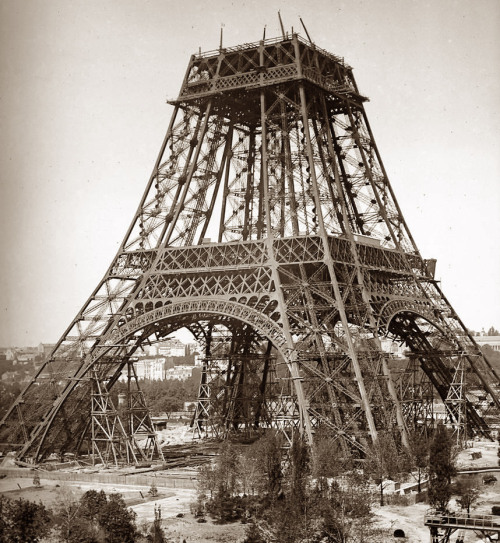
The Eiffel Tower under construction for the 1889 Exposition Universelle, Paris


F1 is more than just racing, it is an engineering battle. In this gif you can see the absolute control of wing tip vortices generated from the front wing. This is just an example to show the extreme aerodynamics that these vehicles are engineered for.
Have a great day!
* What are wing tip vortices ?
** Smoke angels and wing tip vortices
-
 yanderehiro reblogged this · 1 year ago
yanderehiro reblogged this · 1 year ago -
 yanderehiro liked this · 1 year ago
yanderehiro liked this · 1 year ago -
 aris173 liked this · 1 year ago
aris173 liked this · 1 year ago -
 enhype-boys liked this · 1 year ago
enhype-boys liked this · 1 year ago -
 gismeda liked this · 2 years ago
gismeda liked this · 2 years ago -
 thesapphooflesbos reblogged this · 4 years ago
thesapphooflesbos reblogged this · 4 years ago -
 thesapphooflesbos liked this · 4 years ago
thesapphooflesbos liked this · 4 years ago -
 shusheerhshsheshhh liked this · 4 years ago
shusheerhshsheshhh liked this · 4 years ago -
 chaoticphysicsstudent liked this · 4 years ago
chaoticphysicsstudent liked this · 4 years ago -
 wannabe-someone liked this · 4 years ago
wannabe-someone liked this · 4 years ago -
 medeadidnowrong liked this · 4 years ago
medeadidnowrong liked this · 4 years ago -
 numerousbeesinatrenchcoat liked this · 4 years ago
numerousbeesinatrenchcoat liked this · 4 years ago -
 variousthingsandstuffandwhatnot reblogged this · 4 years ago
variousthingsandstuffandwhatnot reblogged this · 4 years ago -
 variousthingsandstuffandwhatnot liked this · 4 years ago
variousthingsandstuffandwhatnot liked this · 4 years ago -
 starhatcher reblogged this · 4 years ago
starhatcher reblogged this · 4 years ago -
 7moments-in-the-stars liked this · 4 years ago
7moments-in-the-stars liked this · 4 years ago -
 castielimpalawinchester liked this · 4 years ago
castielimpalawinchester liked this · 4 years ago -
 gilglirthemaia liked this · 4 years ago
gilglirthemaia liked this · 4 years ago -
 i-love-jack-o-lanterns liked this · 4 years ago
i-love-jack-o-lanterns liked this · 4 years ago -
 lycanfang liked this · 4 years ago
lycanfang liked this · 4 years ago -
 electroweak reblogged this · 4 years ago
electroweak reblogged this · 4 years ago -
 pranksfunandgames liked this · 4 years ago
pranksfunandgames liked this · 4 years ago -
 i-feel-like-a-forest liked this · 4 years ago
i-feel-like-a-forest liked this · 4 years ago -
 nerdaestheticpositivitymug-blog liked this · 4 years ago
nerdaestheticpositivitymug-blog liked this · 4 years ago -
 opinionated-omelet liked this · 4 years ago
opinionated-omelet liked this · 4 years ago -
 lonelyowl17 liked this · 4 years ago
lonelyowl17 liked this · 4 years ago -
 tardigrade666 liked this · 4 years ago
tardigrade666 liked this · 4 years ago -
 secondaristh reblogged this · 4 years ago
secondaristh reblogged this · 4 years ago -
 neverwishingonafallenstar reblogged this · 4 years ago
neverwishingonafallenstar reblogged this · 4 years ago -
 iamme27 liked this · 4 years ago
iamme27 liked this · 4 years ago -
 delicantly liked this · 4 years ago
delicantly liked this · 4 years ago -
 asylumkid liked this · 4 years ago
asylumkid liked this · 4 years ago -
 techjum reblogged this · 4 years ago
techjum reblogged this · 4 years ago -
 lazilycolorfulturtle liked this · 4 years ago
lazilycolorfulturtle liked this · 4 years ago -
 lucky7saint liked this · 4 years ago
lucky7saint liked this · 4 years ago -
 star-crossed-maniac-lunatic liked this · 4 years ago
star-crossed-maniac-lunatic liked this · 4 years ago -
 soullessorionstars liked this · 5 years ago
soullessorionstars liked this · 5 years ago -
 lazybakaghost liked this · 5 years ago
lazybakaghost liked this · 5 years ago -
 karamelakoka liked this · 5 years ago
karamelakoka liked this · 5 years ago -
 rebe0000 liked this · 5 years ago
rebe0000 liked this · 5 years ago -
 driftyapankedi liked this · 5 years ago
driftyapankedi liked this · 5 years ago